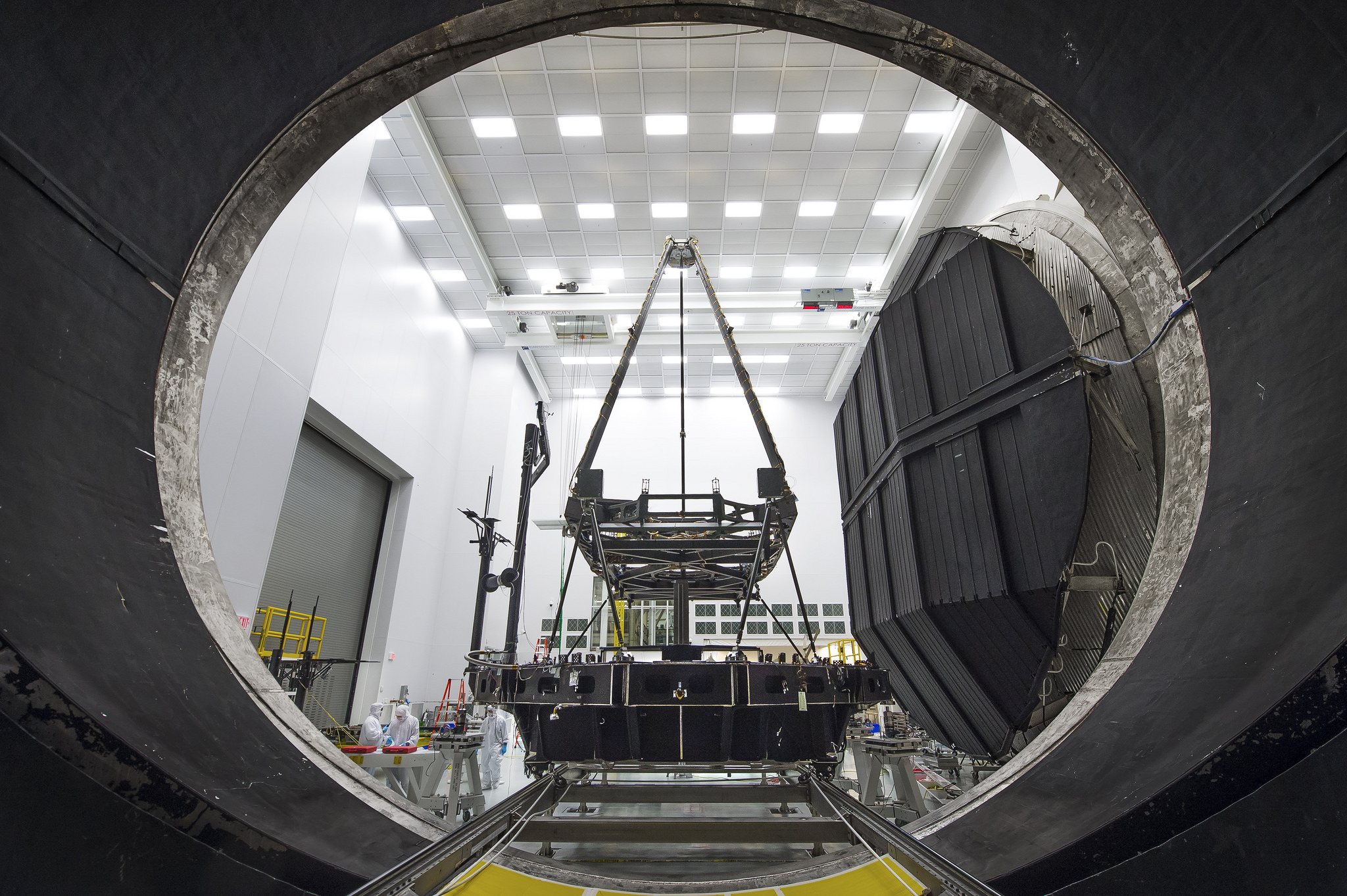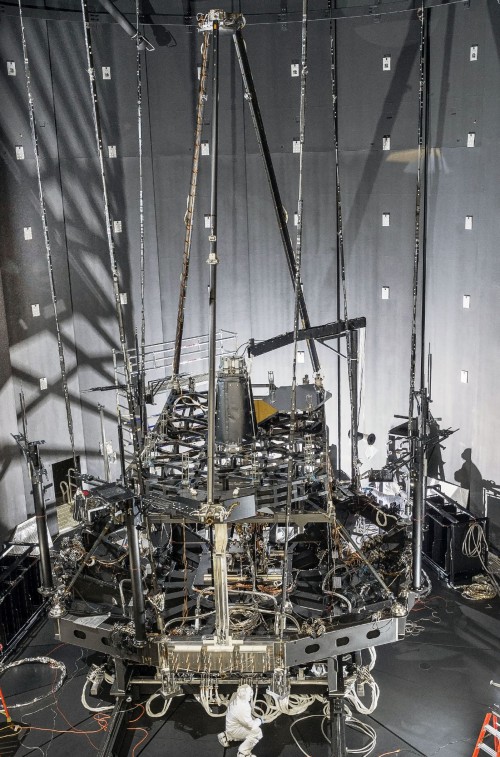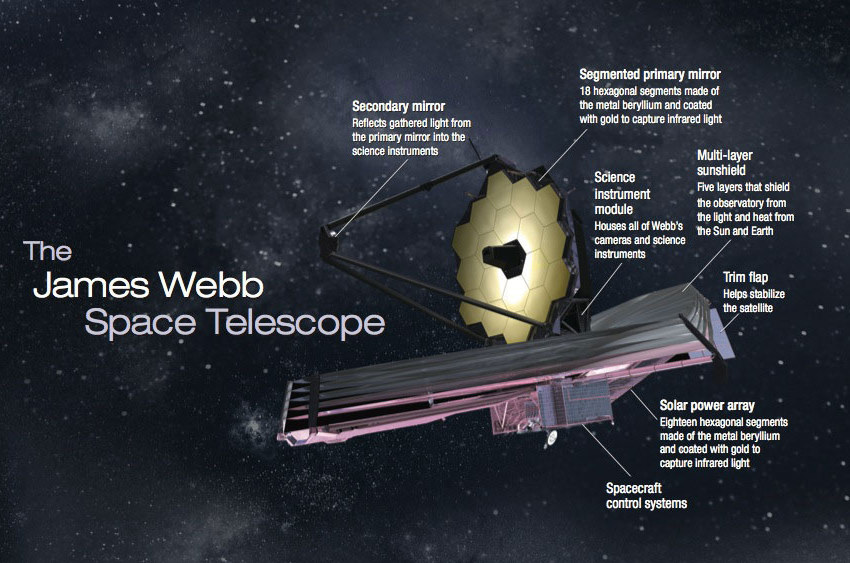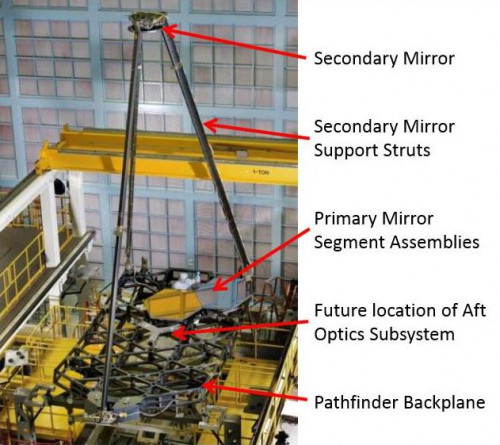
If there is one mantra that drives the development of space mission projects, it’s ‘test, test, test’. Before every successful manned or robotic mission has ever flown to space countless man-hours were devoted for extensive and rigorous testing on the ground in order to ensure that every piece of flight hardware will operate as planned in the harsh environment of space. NASA’s James Webb Space Telescope, or JWST, which is currently under development for a late 2018 launch, is no exception, and engineers at NASA’s Johnson Space Center in Houston, Texas recently put the telescope’s “pathfinder” test article through its first super-cold optical test.
“This test is the first dry-run of the equipment and procedures we will use to conduct an end-to-end optical test of the flight telescope and instruments,” says Mark Clampin, Webb telescope Observatory Project Scientist at NASA’s Goddard Space Flight Center in Greenbelt, Maryland. “It provides confidence that once the flight telescope is ready, we are fully prepared for a successful test of the flight hardware.”

James Webb is steadily coming together at Goddard, where all of its optics, science instruments and support structures are tested and assembled together, and part of this process is an all-important testing of the space telescope’s various optical elements prior to launch. Contrary to Hubble, which was designed to be serviced to be upgraded by astronauts in low-Earth orbit, Webb will be a one-shot deal. Located approximately 1.5 million km away from Earth at the Lagrange point 2, or L2, it will observe the Universe in near and mid-infrared wavelengths, which will require its optics and science instruments to operate at cryogenic temperatures of -400 degrees Fahrenheit (-240 Celsius) while being shielded from the Sun’s light and heat by a large, tennis court-wide sunshield.
Furthermore, the telescope’s 6.5 m-wide primary mirror will consist of a set of 18 hexagonal-shaped smaller segments which once deployed will have to hold their designed shape without deforming in the cryogenic temperatures of space. And with the prospect of being reached by a future astronaut servicing mission out of the question, the James Webb telescope must operate exactly as planned without exhibiting the slightest optical deformation that would render it useless.
In order to meet these overwhelming technical challenges, the project’s engineering teams at NASA and Northrop Grumman (the prime contractor for the James Webb), have devised a series of Optical Ground Support Equipment tests using an exact replica of the telescope’s main optical systems so that the behavior of the mirror segments could be tested in simulated deep-space conditions prior to the their final assembly. Called the ‘Pathfinder’, this replica consists of the main structural elements of the composite backplane similar to the one that will fly in space as part of the real James Webb telescope and includes two full-size spare primary mirror segments and a spare secondary one.
The goal of the Pathfinder tests is to thoroughly check the replica mirror segments in the cryogenic conditions that the flight ones will operate under when the telescope is deployed following its arrival at the L2 Lagrange point. To that end, the JWST engineering teams have been in the process in recent years of revamping the famous cryo vacuum Chamber A at NASA’s Johnson Space Center in Houston, TX, which had previously been used for testing the Apollo spacecraft in the 1960’s.
The conversion of Chamber A for use by the James Webb teams was completed in 2014, when engineers installed the Optical Ground Support Equipment that will be used to cryo test both the structural elements of the Pathfinder as well as those of the fully assembled real James Webb telescope in the next couple of years. The Pathfinder itself arrived at JSC in February of this year where it spent the next few months being prepared for its scheduled Optical Ground Support Equipment tests. The first such test was finally completed successfully earlier in October, during which the Pathfinder underwent a series of optical alignments of its mirror segments in cryogenic temperatures, simulating the procedures that the real James Webb will follow in order to deploy its large 6.5 m-wide mirror in space.
Each of the flight telescope’s mirror segments, including the ones on the secondary mirror, will use a set of actuators that will be responsible for slowly unfolding and aligning all the segments together during the telescope’s trip to the L2 Lagrange point. The whole procedure must be so precise that the mirrors will have to be aligned with an accuracy of less than a fraction of 0.6 micrometers (which is the wavelength of the infrared light that James Webb will observe) in order to be properly focused and operate as one large monolithic mirror, while maintaining their shape in the frigid cold temperatures of deep space. Attaining such an accuracy is no small feat, and the entire design and assembly of the JWST is at the cutting-edge of what technology can achieve today. Thus, the successful completion of the first Pathfinder Optical Ground Support Equipment test is an important milestone on the road to the space telescope’s launch later this decade.

As part of the Pathfinder tests, the primary and secondary mirror segments were intentionally slightly misaligned, so that engineers could check their behavior as actuators successfully arranged them properly per specifications. “The most significant breakthrough was the first-ever cryogenic optical alignment and testing of multiple primary mirror segments in a process known as ‘phasing,'” says Lee Feinberg, Webb telescope Optical Telescope Element Manager at NASA Goddard. “During the demonstration, mirrors that were initially misaligned by millimeters were aligned to each other using actuators operating at -400F to better than one-one-thousandth diameter of a human hair (or a fraction of a wavelength of light) such that the two primary mirror segments were optically equivalent to a single monolithic mirror. In another major achievement, four large super cold windmills carrying steerable cameras were able to measure the alignment of all of the mirrors and structure to better than one-tenth of a millimeter using a process called photogrammetry.”
Apart from the all-important testing of the mirrors’ alignment in cryogenic temperatures, engineers also placed the mirror segments into different orientations which allowed them to test them successfully in different simulated gravity conditions, and check whether the mirrors’ alignment would hold as well on the weightless environment of space as it did on Earth. “To understand a second gravity orientation, think of a cup,” says Feinberg. “When the cup is face up so you can pour water in it, it is vertical to gravity. Now put the cup on its side and it is horizontal to gravity. Mirrors are like cups in this explanation.”

The succesful completion of the first Pathfinder Optical Ground Support Equipment test paves the way for a scheduled second one later this year. The latter is designed to be more complex, allowing engineers to test the telescope’s Aft Optics System that will actually fly in space. The Aft Optics System is part of the James Webb Optical Telescope Element, which is the system responsible for gathering the light coming from space and distributing it to the telescope’s four science instruments. As part of the second upcoming test, engineering teams will also use a source plate that will illuminate the Aft Optics System, in order to simulate the light coming from distant stars, thus allowing them to check the behavior of the Pathfinder’s entire optical system in cryogenic conditions.
The second Pathfinder Optical Ground Support Equipment test will then be followed by a third, and one that is scheduled for early 2016 called “Thermal Pathfinder”, during which the replica telescope systems as well as flight hardware will be checked end-to-end in different temperatures. The results of the Thermal Pathfinder test in particular will be of most importance to the cryogenic testing of the fully assembled flight James Webb telescope that will follow suit in 2017. Any hardware errors that might crop up during the Thermal Pathfinder will allow engineers to correct the actual telescope hardware that will fly in space accordingly, eventually helping to ensure a successful mission for the James Webb telescope.
The construction of the James Webb itself is also progressing steadily, with an important static load testing of its primary mirror backplane structure having being completed successfully in July. During the same time, Northrop Grumman successfully completed the assembly of the telescope’s main bus which will integrate the optical system, sunshield and science instruments, as was announced by the company earlier this month. With the construction of the James Webb now pacing up, the project is still within its schedule and budget estimates in order to meet its 2018 launch date. “We’re doing very well on schedule”, said Jonathan Gardner, Deputy Senior Project Scientist for the James Webb at Goddard, during a recent Google+ Hangout. “Right now we have a plan that gets us to launch in October of 2018 and that has been the same plan for the last four years”.
Billed as the scientific successor to the Hubble, the James Webb space telescope is poised to open up an entirely new window to the Universe once launched, seeing much farther out into the Cosmos in infrared wavelengths, allowing scientists to observe in detail a host of different astrophysical phenomena, from the evolution of the first galaxies that formed after the Big Bang, to the detailed characterisation of exoplanet atmospheres just to name a few. We cannot imagine the things that James Webb’s eyes will reveal, but one thing is for certain – the 2020’s will be a very interesting time for astronomy and astrophysics.
Be sure to “Like” AmericaSpace on Facebook and follow us on Twitter: @AmericaSpace
.
Missions » James Webb Telescope »



Test Test and Test, especially after Hubble.
I think the description of the solar power array is not correct on the picture of the James Webb Telescope.
“Contrary to Hubble, which was designed to be serviced to be upgraded by astronauts in low-Earth orbit, Webb will be a one-shot deal.
Maybe ‘will probably be a one-shot deal’ would be more accurate.
“And with the prospect of being reached by a future astronaut servicing mission out of the question, the James Webb telescope must operate exactly as planned without exhibiting the slightest optical deformation that would render it useless.”
The International Orion visiting the L2 Lagrange halo orbit of the James Webb with a specifically designed mission module could be doable and might be useful to extend the telescope’s productive life at some point in the future.
Perhaps no mortal owns a future technical capabilities and options crystal ball.
And of course, future political considerations concerning trying to extend the telescope’s productive lifespan are a bit unpredictable.
According to the Wikipedia article ‘James Webb Space Telescope’ “The observatory attaches to the Ariane 5 rocket via a launch vehicle adapter ring which could be used by a future spacecraft to grapple the observatory to attempt to fix gross deployment problems.”
Attaching a specifically designed systems enhancement or functions replacement module to that “launch vehicle adapter ring” might someday be used for saving or extending the mission life of the James Webb telescope.
Extended missions, even with a degraded mission capability such as that of NASA’s Wide-field Infrared Survey Explorer (WISE) infrared-wavelength astronomical space telescope, can be quite productive. WISE went into a hibernation mode on February 2011 and was reactivated in September 2013.
An actual “hands on” manned service mission is out of the question because Webb’s mirror is open to space, there’s no hinged cover to protect it as on Hubble. Astronauts and their spacecraft are real pig-pens that would coat Webb’s mirror with all sorts of out-gassed gunk.
A telerobotically operated s/c with the Orion a safe distance away is perhaps possible, depending on the nature of the failure, when it occurs during the life of the telescope and the state of the budgets involved.
Webb is life limited by the on-board propellant used to desaturate the momentum wheels. I have no doubt that small aerospace companies will propose clever small s/c that would dock with that adapter ring to provide propulsion to extend the telescope’s life.
There’s a fascinating back story to all this involving the titanic struggle by planetary astronomers to get Webb’s ability to observe objects in the solar system reinstated, vs the stellar community who didn’t want the added complexity (read $$$$) and a shortened on-orbit life so the telescope could slew & track stuff in our own back yard…but I digress.
se jones – “A telerobotically operated s/c with the Orion a safe distance away is perhaps possible, depending on the nature of the failure, when it occurs during the life of the telescope and the state of the budgets involved.”
Perhaps an International Orion with two or three or four intelligent humanoid robots as the crew instead of humans will be doable in twenty to thirty years.
And the the Orion’s Service Module may eventually include a version that uses small ion, hot H2, antimatter, or zero propellant Mach effect thrusters.
A “hinged cover” to protect the Webb’s mirror during maintenance missions might be the first future L2 modification to the telescope.
Learning how to repair, maintain, and upgrade space assets that may or may not have originally been designed to have essentially open-ended lifespans is an essential capability that we human and robotic Earthlings need to gain.
And if we are serious about human space exploration and colonies across our Solar System, both the International Space Station and NASA/ESA Hubble Space Telescope should have open-ended lifespans and many future maintenance and upgrade missions.
If we cannot consistently demonstrate our sophisticated and economical repair, maintenance, and upgrade skills with LEO, GEO, Lunar orbit, Lunar surface, and L1 and L2 Lagrange orbit assets, then we have absolutely no business in foolishly running our mouths by claiming we humans are prepared to survive and thrive on Phobos, Mars, and Ceres.
For near-term antimatter propulsion goals see: ‘Interstellar Space Travel: Antimatter-Powered Rockets Could Make It A Reality’ By David Gilbert October 16 2015 International Business Times.
And thank you Leonidas Papadopoulos for this interesting and useful article!